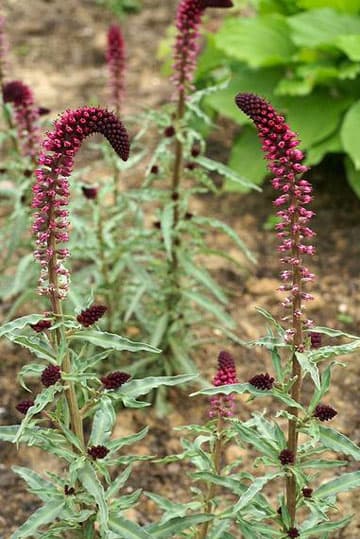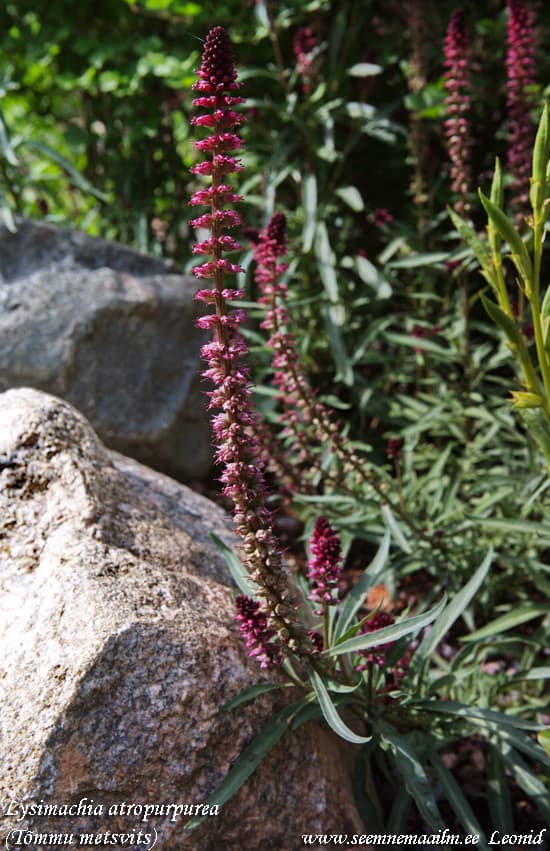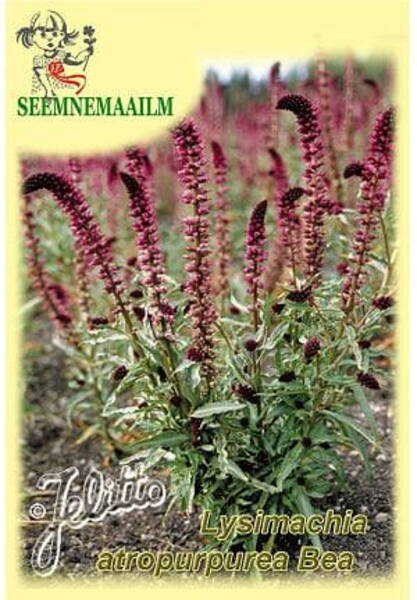Your shopping cart is empty!
Burgundy Loosestrife "Beaujolais"
Burgundy Loosestrife "Beaujolais" - Lysimachia atropurpurea.
Homeland - Greece. Unusual perennial 45-90 cm tall.
Winter hardiness zones: Z3-9.
A delightful display with spikes of many wine-red, almost black flowers contrasting sharply with the silver-green lanceolate leaves. The characteristic and light corrugation along the edge of the leaf is interesting, especially noticeable in young leaves. Forms a bush 45-60 cm in diameter. Blooms from July to August.
An open sunny place or light partial shade and light, well-drained soil, pH 6-7, are required. The plant is drought tolerant but prefers moist soil, so watering is advisable in dry weather. Can be aggressive in warm areas. Easily propagated by seeds. Seedlings are sown in February in a mixture of peat and sand. Sow on the surface, as light is required for germination. Maintains humidity. At a temperature of 13-15 °C, seedlings appear within 10-12 days. Grown seedlings are planted in pots 7.5 cm in diameter. They are planted in a permanent location in June. Before planting in the ground, seedlings must be hardened off. The distance between plants is 45 cm. An excellent plant for the border, can be grown in a container and looks good in a bouquet. Attracts butterflies.
Location: Burgundy loosestrife requires a well-lit place.
Soil: not demanding on growing conditions, but on loose, fertile, moist soils they grow faster, forming a dense canopy after 2-3 years.
Care: they do not need shelter for the winter. During the summer, maintain constant high soil moisture. For vertically growing loosestrife, at the end of flowering, the faded parts of the stems are cut off. In autumn, the stems are cut down and compost is added to the plants. They grow in one place for up to 10 years.
Reproduction: seeds and vegetatively. 1.0 g = 2450 seeds.
For better seed germination, post-sowing stratification for 1-2 months is desirable. Flowering occurs in 2-3 years. They propagate vegetatively by division, rhizome segments, basal suckers and cuttings. Dividing and replanting can be done in early spring, before the leaves appear, or in early autumn (September).
Use: for group plantings. It can cover walls and stones, which is why it is planted in large rock gardens. The "Aurea" variety is also used as a hanging plant for planting in containers. To decorate the shore of a reservoir, dotted loosestrife, common loosestrife, and cletroid are suitable.
Partners: go well in group mixed plantings under the canopy of trees along with astilbe, bells, ferns and other shade-loving perennials.

Homeland - Greece. Unusual perennial 45-90 cm tall.
Winter hardiness zones: Z3-9.
A delightful display with spikes of many wine-red, almost black flowers contrasting sharply with the silver-green lanceolate leaves. The characteristic and light corrugation along the edge of the leaf is interesting, especially noticeable in young leaves. Forms a bush 45-60 cm in diameter. Blooms from July to August.
An open sunny place or light partial shade and light, well-drained soil, pH 6-7, are required. The plant is drought tolerant but prefers moist soil, so watering is advisable in dry weather. Can be aggressive in warm areas. Easily propagated by seeds. Seedlings are sown in February in a mixture of peat and sand. Sow on the surface, as light is required for germination. Maintains humidity. At a temperature of 13-15 °C, seedlings appear within 10-12 days. Grown seedlings are planted in pots 7.5 cm in diameter. They are planted in a permanent location in June. Before planting in the ground, seedlings must be hardened off. The distance between plants is 45 cm. An excellent plant for the border, can be grown in a container and looks good in a bouquet. Attracts butterflies.
Location: Burgundy loosestrife requires a well-lit place.
Soil: not demanding on growing conditions, but on loose, fertile, moist soils they grow faster, forming a dense canopy after 2-3 years.
Care: they do not need shelter for the winter. During the summer, maintain constant high soil moisture. For vertically growing loosestrife, at the end of flowering, the faded parts of the stems are cut off. In autumn, the stems are cut down and compost is added to the plants. They grow in one place for up to 10 years.
Reproduction: seeds and vegetatively. 1.0 g = 2450 seeds.
For better seed germination, post-sowing stratification for 1-2 months is desirable. Flowering occurs in 2-3 years. They propagate vegetatively by division, rhizome segments, basal suckers and cuttings. Dividing and replanting can be done in early spring, before the leaves appear, or in early autumn (September).
Use: for group plantings. It can cover walls and stones, which is why it is planted in large rock gardens. The "Aurea" variety is also used as a hanging plant for planting in containers. To decorate the shore of a reservoir, dotted loosestrife, common loosestrife, and cletroid are suitable.
Partners: go well in group mixed plantings under the canopy of trees along with astilbe, bells, ferns and other shade-loving perennials.


Burgundy Loosestrife.












